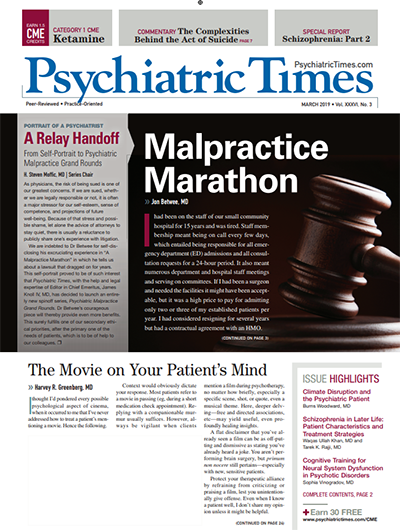Publication
Article
Psychiatric Times
The Movie on Your Patient’s Mind
Author(s):
Inquiring about a patient’s favorite movie sometimes proves unexpectedly revealing.
agsandrew/Shutterstock

I thought I’d pondered every possible psychological aspect of cinema, when it occurred to me that I’ve never addressed how to treat a patient’s mentioning a movie. Hence the following.
Context would obviously dictate your response. Most patients refer to a movie in passing (eg, during a short medication check appointment). Replying with a companionable murmur usually suffices. However, always be vigilant when clients mention a film during psychotherapy, no matter how briefly, especially a specific scene, shot, or quote, even a musical theme. Here, deeper delving-free and directed associations, etc-may yield useful, even profoundly healing insights.
A flat disclaimer that you’ve already seen a film can be as off-putting and dismissive as stating you’ve already heard a joke. You aren’t performing brain surgery, but primum non nocere still pertains-especially with new, sensitive patients.
Protect your therapeutic alliance by refraining from criticizing or praising a film, lest you unintentionally give offense. Even when I know a patient well, I don’t share my opinion unless it might be helpful.
Case in point: a woman with ruinous self-esteem was devastated when would-be cognoscenti at a Gotham dinner party savaged her because she found The English Patient a terminal bore. Wasn’t she aware that the best critics, as well as Manhattan at large, were certain it was Oscar-bound?
She was comforted when I said that I, too, thought the picture a bloated bore. My agreement strengthened a dawning recognition spurred by our work that she wasn’t a socially inept utter boob-her rancorous husband’s default perception. (Of course, I defend to the death your right to admire The English Patient. Even professional film criticism may rationalize private taste into the public area.)
Patients in therapy frequently worry that speaking about a film I haven’t seen will ruin it for me. I emphasize they needn’t be concerned. Knowing in advance that Russell Crowe’s gladiator or the semi-toasted English Patient expires before the credits roll comprises yet another example of the frustrations Freud said came with the job. If a patient’s concern stems from an irrational fear of my disapproval, that’s another matter, calling for exploration.
Hearing about a film is never the same as seeing it. I watch movies many times, including those I review and dislike (I’ve occasionally changed my mind the second time around). Viewing a film or other art work again can enhance insight; so can watching a new film or reading a book that is significant to your patient. And, it may enrich your insight beyond the current treatment.
I often use film as an inexpensive Rorschach during an initial mental status evaluation or later in therapy. The result usually doesn’t indicate much that you didn’t already know. But inquiring about a patient’s favorite movie sometimes proves unexpectedly revealing.
Case in point: the prized movie of a 17-year-old youngster crippled by OCD was The Wizard of Oz. I expected her favorite character would be plucky Dorothy, but instead it was the Tin Man, “My obsessions make me feel just as frozen in place-until Dorothy comes along with that oil-can. Maybe you have one!”
I’m wary of using cinema to teach psychiatric diagnosis or treatment. With rare exceptions, movies aren’t deliberately produced to teach audiences about anything: psychiatry, sinus lifts, or rose gardening. Education may happen, but chiefly it’s a byproduct of telling a riveting tale in aid of boffo box-office. If clinical accuracy has to be sacrificed for moving the plot along, so be it.
A few studies claim benefits from showing a movie to an individual or group of patients suffering from one or another disorder. This probably affords temporary relief to some sufferers, but I’m dubious about long-term relief. I have, however, recommended a film when I think it might energize insight, but not often, and only when I know the client well.
I once treated a gifted young writer who developed a catastrophic depression when his wealthy fiancée suddenly broke off their engagement. Her tycoon father witheringly criticized my patient’s working-class background and occupation. She had fled the lash of his iron will to marry my patient, only to quail before her father when he threatened to disinherit her.
Several months later my patient met another woman with a striking physical resemblance to his former fiancée but a totally dissimilar personality. No fool, she had begun to suss out the distorted basis for their relationship and was backing off. When his desolation bred suicidal fantasies, I recommended Alfred Hitchcock’s Vertigo (1958).
Hitchcock’s masterpiece devolves around a retired detective’s (James Stewart) desperate attempt to remake-Pygmalian-like-a shop-girl (Kim Novak) into a simulacrum of the beguiling, supposedly suicidal high-society wife he had been asked to protect by her (unknown to him) murderous husband.
Stewart’s character had fallen in love with her, then suffered a devastating depression after being unable to save her from jumping to her death, due to the acrophobia that had compelled his retirement. The detective eventually discovers he’s been cruelly hoaxed: the socialite he knew and the shopgirl are the same woman; the latter used, then discarded by the husband after he killed the “original.”
Exploring my patient’s reaction to Vertigo was crucial in grieving his loss. He eventually recognized that long-standing irrational feelings of not being “good enough” had enforced his conviction he had been responsible for his fiancée’s feckless abandonment. “Just like Stewart, I fooled myself trying to make a new lover into a mirror of my fiancee,” he concluded, “it was like trying to fix an amputated arm by shoving a pros- thesis into a bloody socket.”
My most memorable case in which probing a film was central to effective psychotherapy was that of a 35-year-old Vietnam vet. Despite an apparently healthy return to civilian life, he was increasingly savaged by long-disavowed post-traumatic psychopathology.
He came from a tough urban ghetto. When he was arrested for petty theft at 18, the judge offered him enlistment as an alternative to jail. He turned out to be an exemplary soldier, rose quickly through the ranks, and eventually commanded a platoon in Viet Nam.
He was a huge fan of war movies, particularly Objective, Burma! (1945), in which Errol Flynn headed a daredevil commando team. Identifying strongly with the hero’s unflagging competence and love for his men, he was certain he could bring his “guys” back home safely.
He nearly did, until an ambush during their last week of active duty, killed or grievously wounded most of his outfit. He escaped harm, rendering his guilt even more intolerable. He finally entered treatment, convinced that “a man like Errol Flynn would have gotten us through-and I wasn’t that man.” Over several years of psychotherapy, my patient discovered that Flynn’s unfailingly resourceful captain represented a neurotic ego-ideal, woven from adolescent omnipotent fantasies.
Like any therapist, I’m not immune to the pitfalls of countertransference. It’s especially difficult to avoid gabbing about movies with a fellow addict who just happens to be my patient. He or she may be creating a diversion so as not to deal with the headier stuff. But I admit to having taken the bait on occasion, at least temporarily.
I acknowledge this ad hominem rationalization, but I suspect the Founding Father himself went on and on about some item from his enormous collection of antiquities with the Wolf Man, Rat Man, and company, beyond the object’s therapeutic merit. As far as I know, neither the earlier hagiographers nor acrimonious bashers from the Freud wars have had anything to say on that subject.






